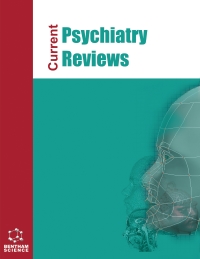- Home
- A-Z Publications
- Current Psychiatry Reviews
- Previous Issues
- Volume 9, Issue 2, 2013
Current Psychiatry Reviews - Volume 9, Issue 2, 2013
Volume 9, Issue 2, 2013
-
-
An Outline of the Historical and Clinical Aspects of Catatonic Schizophrenia
More LessAuthors: Gabor S. Ungvari, Stephan C. Mann and Stanley N. CaroffCatatonic schizophrenia has been an integral part of all psychiatric classifications for over a century. However, based on the recommendation of a panel of experts, catatonic schizophrenia as an independent diagnostic entity will probably be removed form DSM-V. This review paper summarizes the history, psychopathology and clinical features of catatonic schizophrenia and argues that a cluster of loosely defined, simple and co Read More
-
-
-
Catatonia in Affective Disorders
More LessAuthors: Rozalia Takacs and Zoltan RihmerCatatonia was described by Kahlbaum in 1874 as a putative disease entity and was subsumed under dementia praecox by Kraepelin in 1896. Although a number of studies attested to the occurrence of catatonia in several other clinical conditions (major psychiatric disorders and organic brain disturbances), its place in modern classifications is still debated. While the traditional clinical stereotype have equated catatonia wi Read More
-
-
-
Catatonia Due to a General Medical Condition (Organic Catatonia)
More LessAuthors: Brendan T. Carroll, Brian Mendenhall, Francisco Appiani, David Spiegel and William McDanielWhile much has been written about catatonia, there are only a few scholarly reviews focused on catatonia due to a general medical condition, also referred to as organic catatonia. There has been a long list of causative conditions that account for the development of organic catatonia which are informative but not clinically helpful. We performed a literature search using the term ‘catatonia’ covering the last ten years. We found Read More
-
-
-
Catatonia, Malignant Catatonia, and Neuroleptic Malignant Syndrome
More LessAuthors: Stephan C. Mann, Stanley N. Caroff, Gabor S. Ungvari and E. Cabrina CampbellMalignant catatonia (MC) represents a life-threatening neuropsychiatric disorder that was widely reported long before the introduction of antipsychotic drugs. A review of the world literature on MC indicates that although the prevalence of the condition may have declined since the pre-antipsychotic drug era, it continues to occur and represents a syndrome rather than a specific disease. Although most often the outgro Read More
-
-
-
Pediatric Catatonia: Updating An Old Syndrome in Young People
More LessAuthors: Dirk Dhossche, Lee E. Wachtel, Edward Shorter and Neera GhaziuddinThere has been renewed interest in the demarcation of pediatric catatonia from other pediatric conditions including autism. An update on symptoms, prevalence, evaluation, treatment, risk factors, and experimental models of pediatric catatonia is presented. Recent prevalence rates of pediatric catatonia vary widely across studies, suggesting that catatonia may not be rare in younger patients. Symptoms and diagnostic Read More
-
-
-
Diagnosing and Treating Catatonia: An Update
More LessAuthors: Gabor Gazdag and Pascal SienaertCatatonia is a severe neuropsychiatric syndrome comprising a variety of signs and symptoms ranging from simple motor signs to complex behavioural abnormalities. If recognized and treated early, catatonia usually has an excellent prognosis. Observation and psychiatric interview will not suffice to detect the catatonic syndrome, since the most striking symptoms such as posturing, are present only in a minority of the c Read More
-
-
-
Thiol Metabolism in Schizophrenia: Current Status
More LessAuthors: Paul L. Wood and Julie A. WoodObjectives: Our understanding of the pathogenesis of schizophrenia is limited. In this regard, there have been a number of reports of altered thiol metabolism in schizophrenia. The aim of this review is to integrate disparate published findings into a more global overview of altered thiol metabolism and the potential role of thiol therapy in schizophrenia. Methods: Publications of thiol measurements in different metabolic c Read More
-
-
-
Trough Plasma Concentrations of Mifepristone Correlate with Psychotic Symptom Reductions: A Review of Three Randomized Clinical Trials
More LessAuthors: Christine Blasey, Carina McLain and Joseph BelanoffBackground: The relationship between plasma concentrations of psychiatric medications and their efficacy is rarely evaluated or relied upon in clinical practice. While it is generally accepted in clinical settings that patients respond to varying doses of medication, few studies have formally tested whether plasma concentrations of psychiatric medicine predict patients’ responses. We hypothesized that the amount of mifepris Read More
-
-
-
A Conceptual Framework of Comorbidity for Investigation in the Context of Psychiatric Disturbance
More LessComorbidity among people with psychiatric conditions is common and is associated with complicated course, poorer treatment outcomes, higher rates of treatment utilization, and higher risk of mortality. However, research on comorbidity continues to be under-represented in the field. This paper presents the Integrated Framework of Comorbidity to promote and improve research and clinical development in the treatment o Read More
-
-
-
Smoking Cessation in Schizophrenia
More LessAuthors: Elaine Weiner and Saeed AhmedPeople with schizophrenia continue to smoke at higher rates than the general population. Yet, care providers do not routinely aggressively treat this addiction, despite an extensive literature supporting that people with schizophrenia can tolerate cessation attempts. The rationale for not treating smoking addiction will be addressed, and then the intervention literature reviewed. Some clinical issues and areas which need for furthe Read More
-
Most Read This Month
Article
content/journals/cpsr
Journal
10
5
false
en


